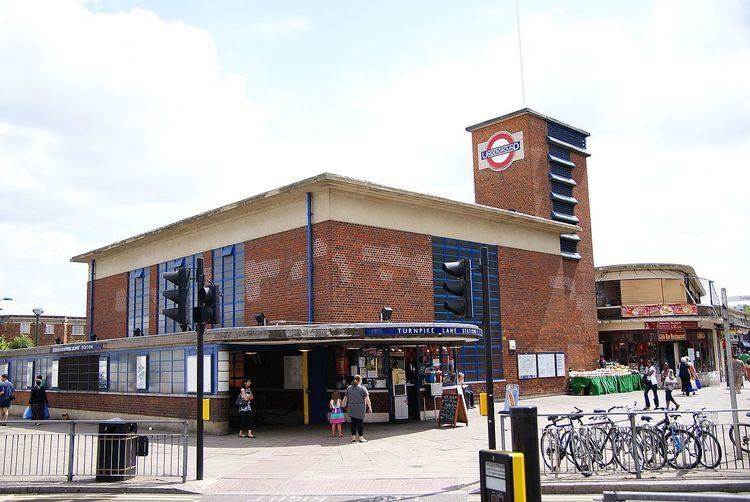Location Turnpike Lane Fare zone 3 2013 10.29 million Address London, United Kingdom Architectural style Modern architecture | 2012 9.60 million 2014 10.77 million Opened 19 September 1932 Number of platforms 2 | |
 | ||
Similar Wood Green tube station, Manor House tube station, London Underground, Arnos Grove tube station, Bounds Green tube station | ||
Turnpike Lane is a station on the Piccadilly line of the London Underground, between Manor House and Wood Green, in Travelcard Zone 3.
Contents
It is in the London Borough of Haringey. Opened on 19 September 1932, it was the first Underground station in the Municipal Borough of Tottenham. It directly serves Turnpike Lane.
Like all stations on the Cockfosters extension, Turnpike Lane set new aesthetic standards not previously seen on the Underground. During the planning period for the extension to Cockfosters, alternate names for this station (North Harringay and Ducketts Green (Ducketts Common is located opposite)) were considered but rejected.
Architectural style
The station was designed by the architect Charles Holden and is a well-preserved example of the modernist house style of London Transport in the 1930s. It was listed at Grade II in 1994. The ticket hall is an enormous brick box, with two large ventilation towers, half-sunk into the surrounding ground. Its high walls contain segmented windows that allow natural light to shine far into the station. The effect in late afternoon light is akin to that in a cathedral transept. Two of the street entrances gave access to the tram routes to and from Alexandra Palace via tramway island exits into Turnpike Lane. These tram services were withdrawn in 1938 and replaced by buses, which continued to use the tram islands until 1968 when they were removed.
The sub-surface areas are tiled in biscuit coloured tiles lined with yellow friezes. The booking hall is 12 feet (3.7 metres) below street level. In common with Manor House and Wood Green, the station tunnels have a diameter of 23 feet (7 metres) and were designed for the greater volume of traffic expected. Bounds Green and Southgate have only 21 foot (6.4 metres) diameter platform tunnels. The construction of "suicide pits" between the rails was also innovative. These were built in connection with a system of passageways under the platforms to give access to the track.
The bus station at the back of the station complex was covered in 1968 as part of a "reshaping plan" of London bus services. The roof has since been removed as part of the rebuilding in the late 1990s.
Future
In May 2013 it was announced that the station would be on the latest proposed route for Crossrail 2. This route is on the Cheshunt branch of Crossrail 2.
Popular culture
The station is mentioned in the song "Junkie Doll" by Mark Knopfler on his album Sailing to Philadelphia, and also in "Los Angeles Waltz" by Razorlight on their self-titled album, Razorlight.
Connections
London Buses routes 29, 41, 67, 121, 123, 141, 144, 184, 217, 221, 230, 231, 232, 329, 444 and W4 and night routes N29 and N91 serve the station.
